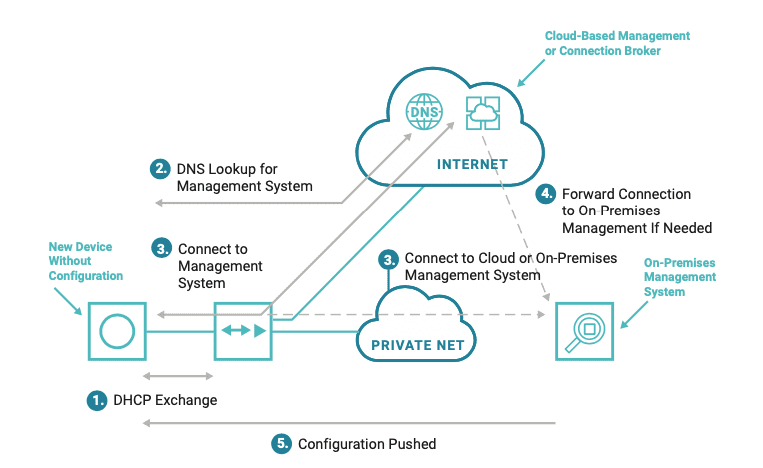But when you use zero touch provisioning, you automate all of these necessary tasks so that devices become configured and operational — with little or no user input. Of course, ZTP is not a turnkey solution offering total plug-n-play simplicity, but it does significantly reduce your workload when provisioning and deploying new locations.

What Goes Into Zero Touch Provisioning?
Even though zero touch provisioning automates and simplifies scaling, it still requires you to make preparations to get devices up and running. These preparations can include things like predetermining console port assignments and ethernet management ports. Also, you need to test and adjust configuration settings in your test environment, so that your devices are configured properly when it comes time to deploy.
ZTP requires you to put forth effort up front, but it pays off later when scaling with new data center and branch locations. With your preparations in place, ZTP eliminates the need for repetitive manual work, and instead gives you streamlined, consistent provisioning.
Several companies are also including zero touch provisioning features in their hardware, through DHCP, Preboot Execution Environment (PXE), and other custom services and apps. For example, some hardware vendors now have devices that, when unable to find a startup configuration, automatically enter zero touch provisioning mode, which allows them to execute the proper scripts for configuration.
Devices that come with ZTP features can help to further reduce your workload. But even when you use them, best practices call for you to have:
- The right scripting and automation tools
- A properly designed ZTP workflow
Adequate scripting and automation tools are just as important as the hardware you choose to deploy. This not only helps with ZTP, but also helps you avoid vendor lock-in down the road when performing additional management and scaling. For example, using an open infrastructure platform such as ZPE Systems’ Nodegrid allows you to employ the tools of your choice, while also giving you serial console accessibility via SSH. Use Puppet, Chef, Ansible, and others as needed. Nodegrid also extends ZTP capabilities to connected devices, regardless of vendor.
Along with having an environment that supports the right tools, zero touch provisioning works best when you develop a preparations workflow. You want every deployment to go smoothly, and this workflow helps you strive to achieve a more streamlined provisioning process. It starts with having a plan even before your hardware goes in the rack. Here’s a top-level overview of what should be part of your plan:
- Ensure your devices are configured for ZTP.
- Inventory your devices so that you know what hardware is at each location. A manufacturer or vendor-provided list can help you document MAC addresses, model & serial numbers, and other critical device data.
- Add your device inventory to your device database, so that data can be handled and configured during provisioning.
- Use your test environment to configure ZTP scripts, and then script and automate to your device database.
How Does Nodegrid Improve Zero Touch Provisioning?
Whether for your data center or branch locations, Nodegrid can help you with zero touch provisioning that’s open and flexible.
Not only can Nodegrid devices leverage existing ZTP features of your infrastructure, using capabilities such as SSH to serial consoles, but they can also serve as the local configuration repository if you’re preconfiguring and shipping devices. They can store, deploy, and archive configurations, allowing you to extend ZTP to other appliances, including those that don’t come with ZTP features.
For more distributed and remote sites, Nodegrid supports 4G/LTE cellular connectivity that allows you to deploy ZTP from anywhere through ZPE Cloud. You can ship bare-metal devices and stay protected knowing that sensitive data can’t get lost or stolen. Once these devices reach their appropriate destination, you can use ZPE Cloud to download and run all your automation scripts, for automatic and consistent provisioning.
Don’t miss out!
Now that you know more about zero touch provisioning and how it helps you scale, make sure you stay up to date for all the latest about ZTP. Subscribe for updates and be the first to see new, helpful content.
